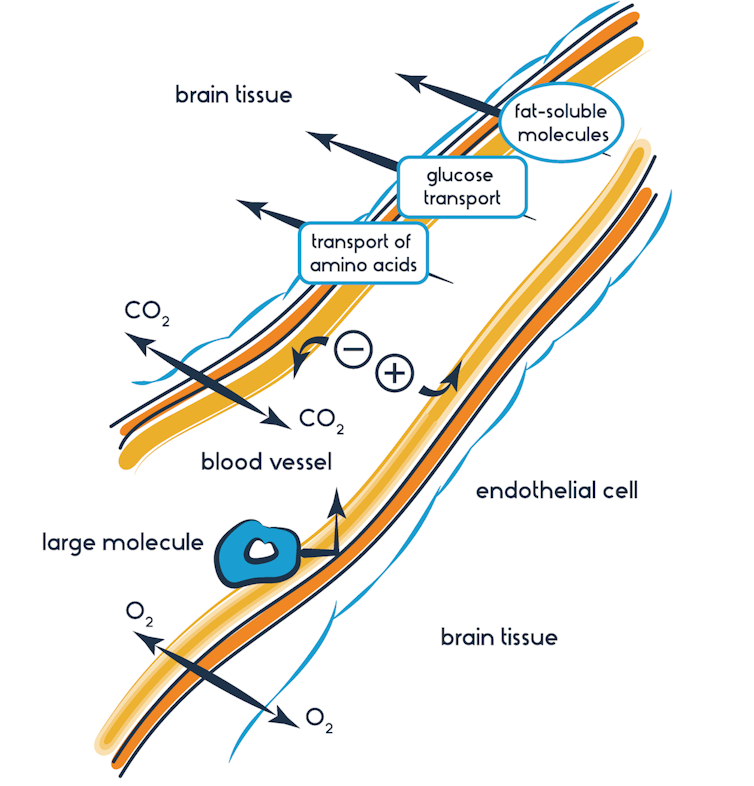The Blood-brain Barrier Is Effective Agains
The brain is precious, and evolution has gone to nifty lengths to protect it from damage. The most obvious is our 7mm thick skull, but the brain is also surrounded by protective fluid (cerebrospinal – of the brain and spine) and a protective membrane called the meninges. Both provide further defence against physical injury.
Some other protective chemical element is the blood–brain barrier. Every bit the name suggests, this is a barrier between the brain's blood vessels (capillaries) and the cells and other components that brand up encephalon tissue. Whereas the skull, meninges and cerebrospinal fluid protect confronting physical impairment, the blood–encephalon bulwark provides a defence confronting disease-causing pathogens and toxins that may be present in our blood.
The claret–brain bulwark was discovered in the belatedly 19th century, when the German medico Paul Ehrlich injected a dye into the bloodstream of a mouse. To his surprise, the dye infiltrated all tissues except the encephalon and spinal cord. While this showed that a barrier existed between brain and blood, it wasn't until the 1960s researchers could use microscopes powerful enough to determine the physical layer of the claret–brain bulwark.
We now know the primal structure of the claret–brain bulwark that offers a barrier is the "endothelial tight junction". Endothelial cells line the interior of all blood vessels. In the capillaries that form the blood–encephalon barrier, endothelial cells are wedged extremely close to each other, forming so-called tight junctions.
The tight gap allows only modest molecules, fatty-soluble molecules, and some gases to laissez passer freely through the capillary wall and into encephalon tissue. Some larger molecules, such as glucose, can gain entry through transporter proteins, which human activity like special doors that open only for particular molecules.
Surrounding the endothelial cells of the claret vessel are other components of the claret–brain barrier that aren't strictly involved in stopping things getting from blood to brain, simply which communicate with the cells that form the barrier to change how selective the claret–encephalon barrier is.
Why do nosotros need it?
The purpose of the blood–brain barrier is to protect against circulating toxins or pathogens that could cause encephalon infections, while at the aforementioned time assuasive vital nutrients to accomplish the brain.
Its other function is to help maintain relatively constant levels of hormones, nutrients and h2o in the brain – fluctuations in which could disrupt the finely tuned environment.

So what happens if the claret–brain barrier is damaged or somehow compromised?
1 common fashion this occurs is through bacterial infection, as in meningococcal disease. Meningococcal leaner tin bind to the endothelial wall, causing tight junctions to open slightly. As a result, the blood–brain barrier becomes more porous, allowing bacteria and other toxins to infect the encephalon tissue, which can lead to inflammation and sometimes death.
It's also thought the blood–encephalon bulwark's function tin can decrease in other conditions. In multiple sclerosis, for example, a defective blood–brain barrier allows white claret cells to infiltrate the brain and set on the functions that send messages from one brain jail cell (neuron) to another. This causes problems with how neurons betoken to each other.
When practise we need to get through information technology?
The blood–brain bulwark is generally very effective at preventing unwanted substances from accessing the brain, which has a downside. The vast bulk of potential drug treatments do not readily cross the barrier, posing a huge impediment to treating mental and neurological disorders.
One possible manner around the problem is to "trick" the blood–brain barrier into allowing passage of the drug. This is the and then-called Trojan horse arroyo, in which the drug is fused to a molecule that can pass the blood–encephalon bulwark via a transporter protein.
A unlike approach is to temporarily open the blood–encephalon bulwark using ultrasound.
In a mouse with Alzheimer's disease, we showed that using ultrasound to open the blood–brain barrier can improve cognition and subtract the corporeality of toxic plaque that accumulates in the brain. We recall this may be due to the power of ultrasound, in combination with injected gas microbubbles, to temporarily and safely open up up the blood–brain barrier to let protective blood-borne factors in. Importantly, this approach didn't damage the brain.
In a new study, nosotros accept shown that by temporarily opening the blood–brain barrier, ultrasound allows more of a therapeutic antibody into the brain, improving Alzheimer's-like pathology and cognition more than when using ultrasound or the antibody drug in isolation.
Ultrasound is therefore a promising tool for temporarily and safely overcoming the normally very useful, just sometimes problematic, claret–brain barrier. It tin be used to improve delivery of drugs to the brain, and in doing then make treatments for Alzheimer's and other brain diseases more cost-constructive.
This commodity was co-authored past Dr Alan Woodruff, a science author at the Queensland Brain Establish.
Source: https://theconversation.com/explainer-what-is-the-blood-brain-barrier-and-how-can-we-overcome-it-75454
0 Response to "The Blood-brain Barrier Is Effective Agains"
ارسال یک نظر